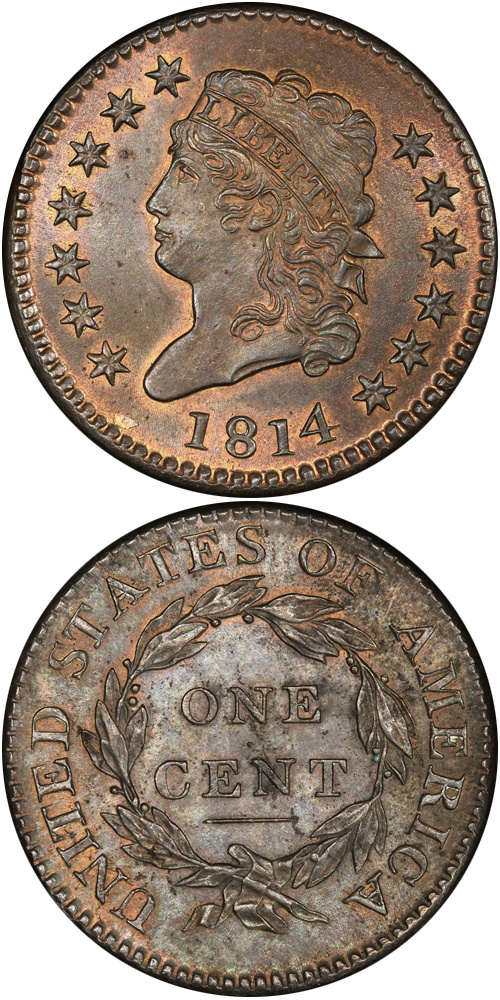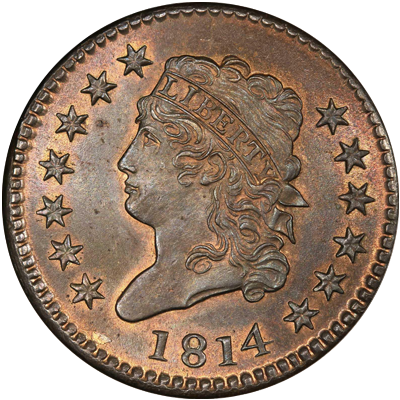Designed by: John Reich
Issue Dates: 1808-1814
Composition: Copper
Diameter: 29 mm
Weight: 10.88 grams (168 grains)
Edge: Plain
Business Strike Mintage: 4,757,722
Proof Mintage: None
The design of the Classic Head large cent is similar to that of the related half cent. The obverse features Miss Liberty, her hair close to her head, with a headband inscribed LIBERTY. Seven stars are to the left and six to the right. The date is below. The reverse displays a continuous wreath tied with a ribbon below, enclosing ONE CENT, with UNITED STATES OF AMERICA surrounding.
There are no major rarities among the 1808-1814 dates, although cents of 1809 are considered to be scarcer than the others. Specimens are readily encountered in all grades from About Good to Extremely Fine. AU examples are rare, and Uncirculated pieces are few and far between. Most examples encountered of the earlier years, 1808 through 1812, are apt to show lightness of strike in certain areas, and even 1813 is not immune from this. In general, 1814 cents are better struck. The planchet coloration also varies, with the earlier years often being a light to medium brown, with later years being dark brown or black. Often the surfaces are microscopically granular. With some searching, you will have no difficulty in locating an attractive Very Fine to Extremely Fine specimen to illustrate the type, although finding a sharply struck piece on a smooth planchet may be a different proposition entirely.
Further Reading
In 1808 the so-called Classic Head cent was introduced. This design, the work of John Reich, was continued through 1814. Miss Liberty, who now faces left and who is viewed from the neck up, is accompanied for the first time by stars, 7 of which appear to the left and 6 to the right. The word LIBERTY appears on a headband, causing some numismatists, Dr. Sheldon among them, to refer to this style as the Turban Head design. The same numismatist, using his medical knowledge, notes that the features of Miss Liberty are "strongly marked and coarse or gynandroid". The reverse, a departure from the previous style, consists of a continuous wreath, not open at the top, with all of the leaves oriented in the same direction along the branch.
Cents of the 1808-1814 years have different personalities than do those immediately preceding. Pieces of 1808 usually are lightly struck and are of a medium color. Cents of 1809, considered to be the scarcest date within the range, usually are light brown and are weakly detailed. Pieces toward the end of the range, 1813 and 1814, are often seen in dark copper, frequently with light porosity. 1814 cents are usually very well defined, with needle-sharp details. Because of this, the type set collector may wish to seek out a specimen of this date.
A number of varieties occur within the 1808-1814 range. The 1810/09 and the 1811/0 overdates are popular as are plain 4 and crosslet 4 varieties of 1814. Specimens of this era are available in all grades, with sharply struck AU and Uncirculated pieces being fairly rare, with the possible exception of 1814 (which is seen more often than the others, but which still is elusive). Fine, Very Fine, and Extremely Fine pieces are seen with frequency.
For a number of years, a "twelve star" 1808 cent was listed in popular references. This is not a true die variety at all but simply represents a 13-star 1808 cent with weak details on one of the stars, due to die failure.
No 1815 cents were struck, although occasionally pieces bearing this date, most often altered by removing the crossbar from the third digit of an 1845 cent (which is of an entirely different design), are encountered. During the last century it was also a popular practice to alter 1813 cents to "1815."
With the minting of the last 1814 cent the curtain came down to close an era in coinage history. Pieces of the 1793 to 1814 years, especially in the early range, were produced under many hardships. Die-cutting, with its attendant errors, variations in the quality of copper and the uncertainty of supplies, and other factors combined to produce millions of cents, no two of which when seen today are precisely alike. Two different pieces of 1794, both of the same die variety and both in the same grade, are apt to differ in some characteristic – whether it be the porosity or lack thereof of the surface, the coloration, the presence or absence of edge nicks or bumps, or whatever. After 1814 things weren't quite the same. Pieces became increasingly stereotyped, and more than ever a magnifying glass is needed today to tell the pieces apart.







